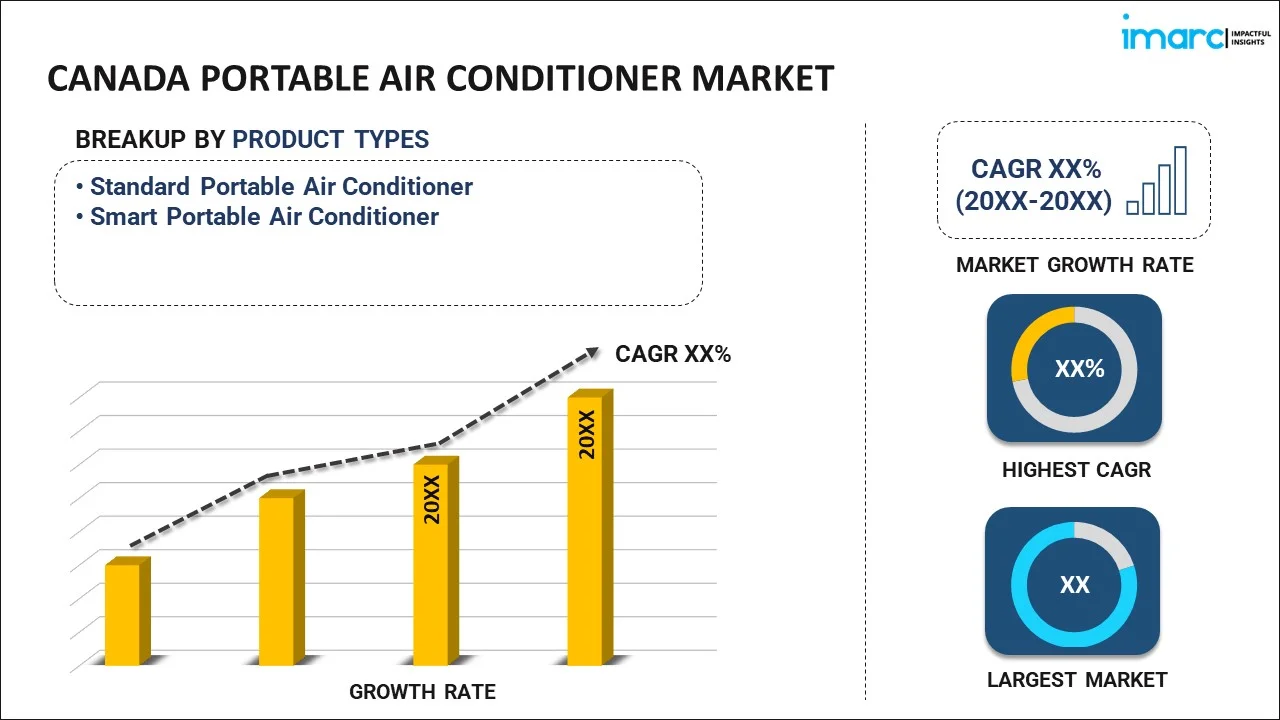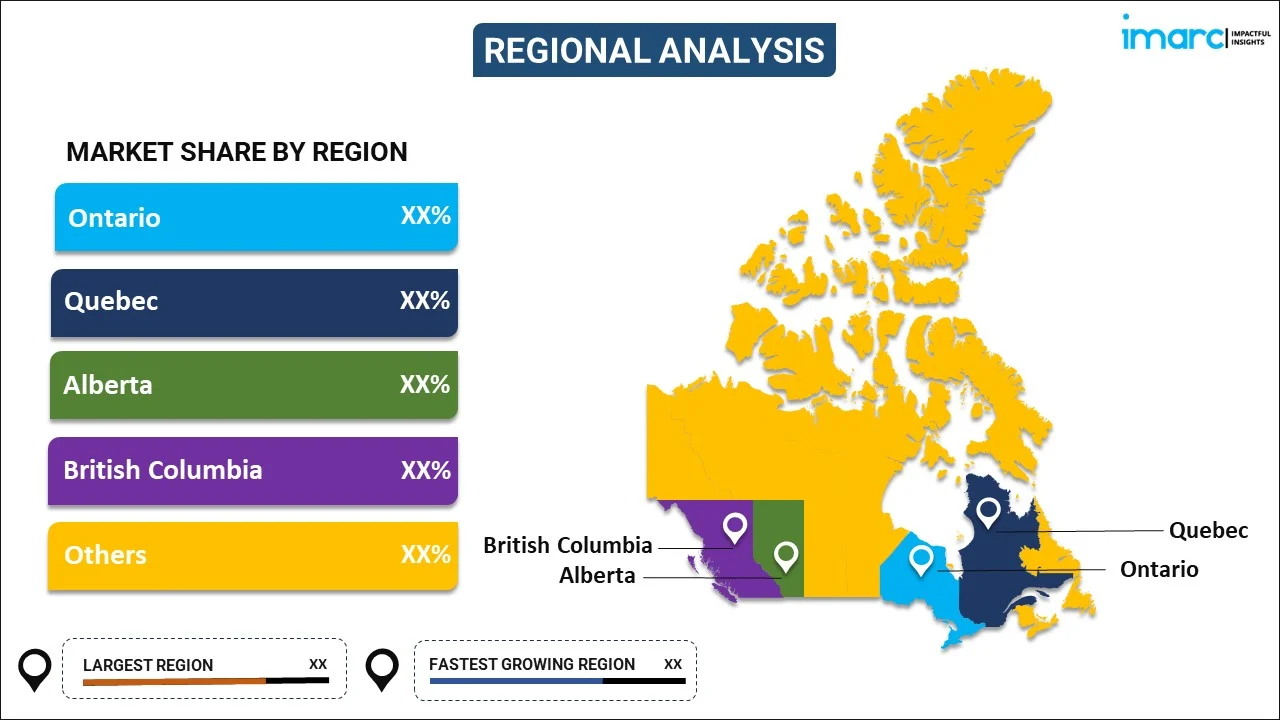
Canada Portable Air Conditioner Market Report by Product Type (Standard Portable Air Conditioner, Smart Portable Air Conditioner), Capacity (Up to 10,000 BTUs, 10,001-15,000 BTUs, Above 15,000 BTUs), Price Range (Below US$ 100, US$ 100-200, US$ 200-700, US$ 700 and Above), End User (Commercial, Residential), Sales Channel (Wholesalers/Distributors, Hypermarkets/Supermarkets, Multi-Brand Stores, Specialty Stores, Independent Small Stores, Online Retailers, and Others), and Region 2024-2032
Canada Portable Air Conditioner Market Overview:
The Canada portable air conditioner market size reached US$ 25 Million in 2023. Looking forward, IMARC Group expects the market to reach US$ 47.8 Million by 2032, exhibiting a growth rate (CAGR) of 7.40% during 2024-2032. The market is propelled by the increasing temperatures and more frequent heatwaves, urbanization and population growth, improvements in energy efficiency and technological advancements, and awareness of the health benefits of maintaining a comfortable indoor environment.
|
Report Attribute
|
Key Statistics
|
|---|---|
|
Base Year
|
2023 |
|
Forecast Years
|
2024-2032 |
|
Historical Years
|
2018-2023
|
| Market Size in 2023 | US$ 25 Million |
| Market Forecast in 2032 | US$ 47.8 Million |
| Market Growth Rate (2024-2032) | 7.40% |
Canada Portable Air Conditioner Market Trends:
Increasing Climate Changes
Climate change has increased the frequency and intensity of heatwaves in Canada, making portable air conditioners a must-have for many households. As per CBC Radio Canada, parts of eastern Canada, including Ontario and Quebec, are seeing more frequent heat waves and tropical nights, defined as nighttime temperatures 20 C or higher. For example, according to theClimate Atlas of Canada, the number of tropical nights in Toronto averaged roughly 6.9 annually from 1976 to 2005. With climate change, under a scenario where carbon emissions decline substantially, that is expected to climb to 17.6 annually from 2021 to 2050. If current rates of carbon emissions continue, the average number of tropical nights in Toronto is expected to hit 20.6 annually from 2021 to 2050. From 2051 to 2080, under the two different scenarios for emissions, the average number would rise to 26.4 and 42.8 respectively. As summers become hotter and more unpredictable, the demand for dependable, adaptable cooling solutions has increased. Portable air conditioners are ideal for Canadian users who may experience fluctuating weather conditions and require a cooling solution that can be quickly transported from room to room or put away when not in use. Portable air conditioners are popular due to their mobility and ability to provide rapid relief during extreme heat conditions. The rising frequency of extreme weather events is predicted to drive demand for portable air conditioners in the Canadian market.
Growing Urbanization
The rise of urbanization, as well as the growing number of people living in apartments and smaller living spaces, has greatly increased demand for portable air conditioners in Canada. In 2021, nearly three in four Canadians (73.7%) lived in one of Canada's large urban centres, up from 73.2% five years earlier. These large urban centres with a population of 100,000 or more people, referred to as census metropolitan areas (CMAs), accounted for most of Canada's population growth (+5.2%) from 2016 to 2021. The suburbs have 78.5% of the total CMA population, with 21.5% in the urban areas. As Canada's population grows, particularly in urban areas such as Toronto, Vancouver, and Montreal, there is a greater demand for residential, commercial, and public infrastructure developments. Portable units, unlike standard central air conditioning systems, do not require permanent installation, making them perfect for rental buildings and smaller living quarters when space is limited. Portable air conditioners are appealing to urban dwellers due to their ease of installation and ability to be moved between rooms as needed. Furthermore, many apartment complexes have restrictions on structural alterations, making portable units a simple and compliant cooling option. The expanding urban population is a major market driver, as more Canadians seek efficient and flexible cooling choices.
Canada Portable Air Conditioner Market News:
- In May 2024, Lennox (NYSE: LII), a leading provider of innovative climate solutions in the HVACR industry, and Samsung, a trusted global brand with 40 years of innovative HVAC technology, announced they have signed an agreement forming a joint venture to sell ductless AC and heat pump (mini-split, multi-split, VRF) products in the United States and Canada. The newly established joint venture will be called Samsung Lennox HVAC North America.
- In February 2024, Honeywell International announced that Hisense, a global consumer electronics and appliance manufacturer, will incorporate Honeywell's energy-efficient Solstice low-global warming potential (GWP) refrigerant into its residential air conditioning units. Hisense units will use Honeywell Solstice® 454B, a low-GWP refrigerant acknowledged for its outstanding performance in both cooling and heating. Hisense's decision to integrate Honeywell's Solstice refrigerant is in line with global efforts to phase out higher GWP refrigerants for air conditioners and heat pumps.
Canada Portable Air Conditioner Market Segmentation:
IMARC Group provides an analysis of the key trends in each segment of the market, along with forecasts at the country level for 2024-2032. Our report has categorized the market based on product type, capacity, price range, end user, and sales channel.
Product Type Insights:

- Standard Portable Air Conditioner
- Smart Portable Air Conditioner
The report has provided a detailed breakup and analysis of the market based on the product type. This includes standard portable air conditioner and smart portable air conditioner.
Capacity Insights:
- Up to 10,000 BTUs
- 10,001-15,000 BTUs
- Above 15000 BTUs
A detailed breakup and analysis of the market based on the capacity have also been provided in the report. This includes up to 10,000 BTUs, 10,001-15,000 BTUs, and above 15000 BTUs.
Price Range Insights:
- Below US$ 100
- US$ 100-200
- US$ 200-700
- US$ 700 and Above
The report has provided a detailed breakup and analysis of the market based on the price range. This includes Below US$ 100, US$ 100-200, US$ 200-700, and US$ 700 and Above.
End User Insights:
- Commercial
- Residential
A detailed breakup and analysis of the market based on the end user have also been provided in the report. This includes commercial and residential.
Sales Channel Insights:
- Wholesalers/Distributors
- Hypermarkets/Supermarkets
- Multi-Brand Stores
- Specialty Stores
- Independent Small Stores
- Online Retailers
- Others
The report has provided a detailed breakup and analysis of the market based on the sales channel. This includes wholesalers/distributors, hypermarkets/supermarkets, multi-brand stores, specialty stores, independent small stores, online retailers, and others.
Regional Insights:

- Ontario
- Quebec
- Alberta
- British Columbia
- Others
The report has also provided a comprehensive analysis of all the major regional markets, which include Ontario, Quebec, Alberta, British Columbia, and others.
Competitive Landscape:
The market research report has also provided a comprehensive analysis of the competitive landscape. Competitive analysis such as market structure, key player positioning, top winning strategies, competitive dashboard, and company evaluation quadrant has been covered in the report. Also, detailed profiles of all major companies have been provided.
Canada Portable Air Conditioner Market Report Coverage:
| Report Features | Details |
|---|---|
| Base Year of the Analysis | 2023 |
| Historical Period | 2018-2023 |
| Forecast Period | 2024-2032 |
| Units | US$ Million |
| Scope of the Report | Exploration of Historical Trends and Market Outlook, Industry Catalysts and Challenges, Segment-Wise Historical and Future Market Assessment:
|
| Product Types Covered | Standard Portable Air Conditioner, Smart Portable Air Conditioner |
| Capacities Covered | Up to 10,000 BTUs, 10,001-15,000 BTUs, Above 15,000 BTUs |
| Price Ranges Covered | Below US$ 100, US$ 100-200, US$ 200-700, US$ 700 and Above |
| End Users Covered | Commercial, Residential |
| Sales Channels Covered | Wholesalers/Distributors, Hypermarkets/Supermarkets, Multi-Brand Stores, Specialty Stores, Independent Small Stores, Online Retailers, Others |
| Regions Covered | Ontario, Quebec, Alberta, British Columbia, Others |
| Customization Scope | 10% Free Customization |
| Post-Sale Analyst Support | 10-12 Weeks |
| Delivery Format | PDF and Excel through Email (We can also provide the editable version of the report in PPT/Word format on special request |
Key Questions Answered in This Report:
- How has the Canada Portable Air Conditioner market performed so far and how will it perform in the coming years?
- What has been the impact of COVID-19 on the Canada Portable Air Conditioner market?
- What is the breakup of the Canada Portable Air Conditioner market on the basis of product type?
- What is the breakup of the Canada Portable Air Conditioner market on the basis of capacity?
- What is the breakup of the Canada Portable Air Conditioner market on the basis of price range?
- What is the breakup of the Canada Portable Air Conditioner market on the basis of end user?
- What is the breakup of the Canada Portable Air Conditioner market on the basis of sales channel?
- What are the various stages in the value chain of the Canada Portable Air Conditioner market?
- What are the key driving factors and challenges in the Canada Portable Air Conditioner?
- What is the structure of the Canada Portable Air Conditioner market and who are the key players?
- What is the degree of competition in the Canada Portable Air Conditioner market?
Key Benefits for Stakeholders:
- IMARC’s industry report offers a comprehensive quantitative analysis of various market segments, historical and current market trends, market forecasts, and dynamics of the Canada Portable Air Conditioner market from 2018-2032.
- The research report provides the latest information on the market drivers, challenges, and opportunities in the Canada Portable Air Conditioner market.
- Porter's five forces analysis assist stakeholders in assessing the impact of new entrants, competitive rivalry, supplier power, buyer power, and the threat of substitution. It helps stakeholders to analyze the level of competition within the Canada Portable Air Conditioner industry and its attractiveness.
- Competitive landscape allows stakeholders to understand their competitive environment and provides an insight into the current positions of key players in the market.
Need more help?
- Speak to our experienced analysts for insights on the current market scenarios.
- Include additional segments and countries to customize the report as per your requirement.
- Gain an unparalleled competitive advantage in your domain by understanding how to utilize the report and positively impacting your operations and revenue.
- For further assistance, please connect with our analysts.
 Inquire Before Buying
Inquire Before Buying
 Speak to an Analyst
Speak to an Analyst
 Request Brochure
Request Brochure
 Request Customization
Request Customization




.webp)




.webp)












